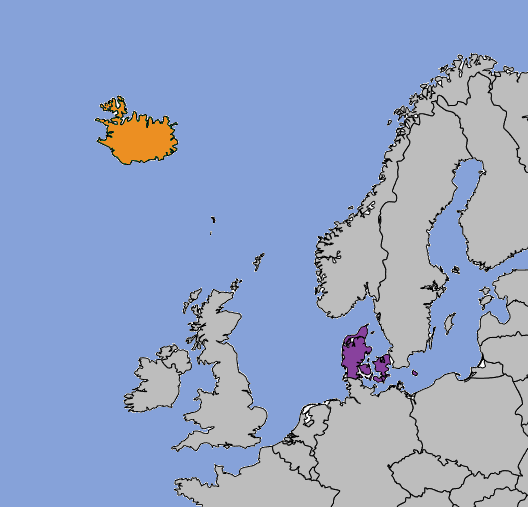Language similarities and differences: Icelandic versus Danish
Icelandic and Danish evolved from Old Norse, the ancient language of the Vikings. So did the other Scandinavian languages.
Icelandic has remained close to the Old Norse language because the geographical isolation of Iceland has sheltered it from the influence of other languages.
While Icelandic has changed little over the centuries, Danish has changed a lot. Danish has been in close contact with other languages (like German). Danish has absorbed many loanwords, and its grammar has also become simpler.

Vocabulary comparison
There are plenty of similar vocabulary words between Icelandic and Danish. Many of these word pairs are cognates, meaning they share a common etymological ancestor, typically a term from Old Norse.
| English | Icelandic 🇮🇸 |
Danish 🇩🇰 |
|---|---|---|
| friend | vinur | ven |
| to love | elska | elske |
| word | orð | ord |
| expensive | dýr | dyr |
| victory | sigur | sejr |
| food | matur | mad |
| to say | segja | sige |
| to grow | vaxa | vokse |
| valley | dalur | dal |
| salary | laun | løn |
| month | mánuður | måned |
| old | gamall | gammel |
| forest | skógur | skov |
Icelandic and Danish both use the Latin alphabet. But some Icelandic letters (like ‘ð’ and ‘þ’) don’t exist in Danish, and some Danish letters (like ‘å’ and ‘ø’) don’t exist in Icelandic.
The previous table showed some similar words, but there are also plenty of words that are very different, which makes sense given that Icelandic and Danish are two different languages (and not two dialects of the same language).
Below are some examples of Icelandic and Danish words which are quite different:
| English | Icelandic 🇮🇸 |
Danish 🇩🇰 |
|---|---|---|
| telephone | sími | telefon |
| difficult | erfiður | svær |
| work | vinna | arbejde |
| cheap | ódýr | billig |
| computer | tölva | computer |
| tölvupóstur | ||
| kitchen | eldhús | køkken |
| hungry | svangur | sulten |
| silent | þögull | stille |
| beautiful | fallegur | smuk |
For more vocabulary words, refer to our lists of the thousand most common words in Icelandic and Danish.
Compared to Danish, Icelandic has been less influenced by other languages
Iceland is an island approximately 600 miles away from mainland Scandinavia, which was settled in the 9th century by Norsemen who spoke the Old Norse language.
For centuries, the geographical isolation of Iceland has sheltered Icelandic from outside linguistic influences.
During that period, Denmark was involved in trade with German cities, and as a result, the Danish language assimilated some German vocabulary words.
Even in the modern era, Icelanders have had an active policy of limiting the inclusion of foreign words into Icelandic.
While the Danish language has adopted foreign vocabulary words like “computer” and “e-mail,” Icelanders have chosen to create new words instead: “tölva” and “tölvupóstur.”
In terms of grammar, Icelandic is more complicated than Danish
Icelandic has remained close to Old Norse —not only vocabulary-wise but also grammar-wise.
Old Norse had three grammatical genders (masculine, feminine, and neuter). Icelandic has kept all three, whereas in Danish, the masculine and feminine grammatical genders have been merged into a common gender, resulting in two instead of three grammatical genders.
In Old Norse, nouns are declined according to four grammatical cases (nominative, accusative, dative, and genitive). That means when nouns appear in a sentence, their endings change to reflect their grammatical function.
Icelandic has kept these noun declensions, whereas Danish has done away with them.
As English evolved from Old to Modern English, it also eliminated the grammatical features mentioned above, just as Danish did. That’s why, to a native English speaker, Danish grammar is easier than Icelandic grammar.
Verb conjugation
Conjugation is another area where the Danish language is more straightforward than the Icelandic language.
Danish verbs have the same form regardless of the subject pronoun. In contrast, Icelandic verbs are conjugated according to the subject pronoun.
As an example, here are the conjugation tables of the verb “to be” in Danish and Icelandic:
Danish is easier to learn than Icelandic
Danish and Icelandic are both Scandinavian languages. And yet, Icelandic is hard to learn, while Danish is comparatively simpler.
Comparing Danish to Icelandic is like comparing Italian to Latin. Both Icelandic and Latin have certain grammatical features in common that used to be widespread among the Indo-European languages, such as noun declensions based on case and three grammatical genders. These same features were also found in Old English.
The Danish language has undergone a series of changes that parallel, in some ways, the transformation of Old English into modern English.
While a speaker of Old English may have found Icelandic to be easier than Danish, a speaker of modern English will likely find Danish to be a much easier language to learn than Icelandic.
Learning Icelandic or Danish: the pros and cons
One of the pros of learning Danish is that it is pretty similar to Swedish and Norwegian (particularly in its written form). Hence by learning Danish, one would have relatively easy access to these other two Scandinavian languages.
On the other hand, language learners with an interest in Norse mythology can benefit from learning Icelandic as it could enable them to read Old Norse literature, and in particular the famous Sagas.
Language learners who do not have an affinity for grammar might enjoy the process of learning Danish more than that of learning Icelandic.
When learning a language, it is helpful to practice with native speakers. One may have an easier time finding a language partner for Danish compared to Icelandic because there are 20 times more native Danish speakers than native Icelandic speakers (6 million vs 300 thousand).
References:- [1] (Map license)